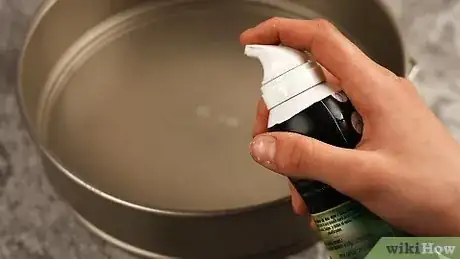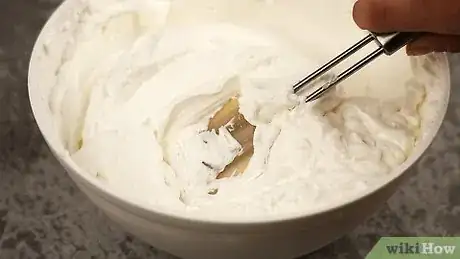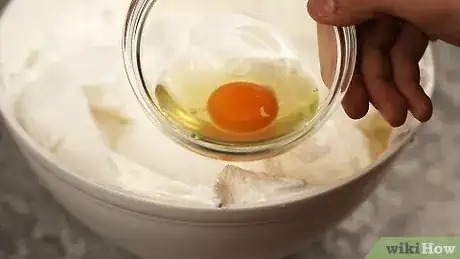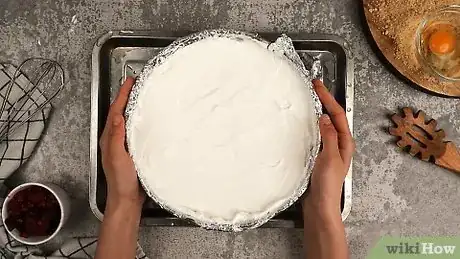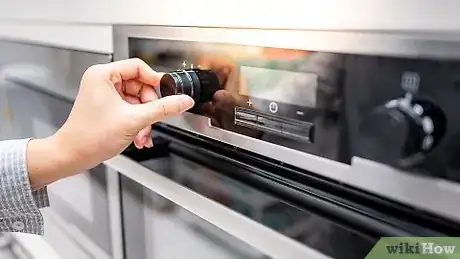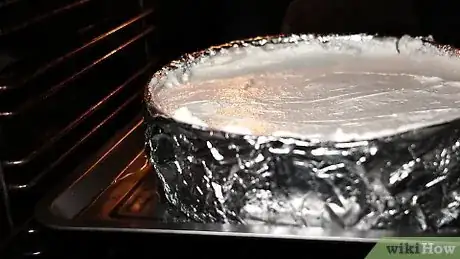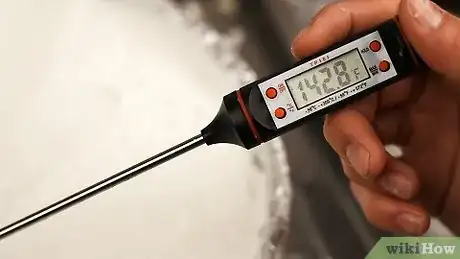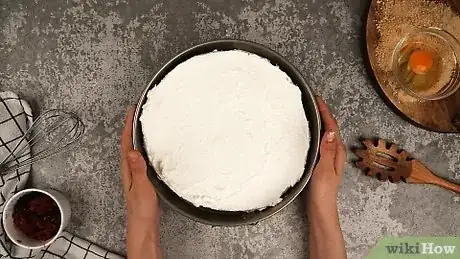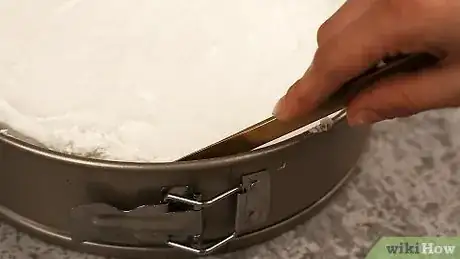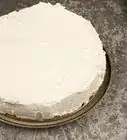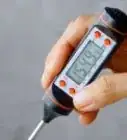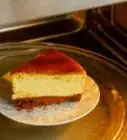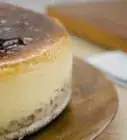wikiHow is a “wiki,” similar to Wikipedia, which means that many of our articles are co-written by multiple authors. To create this article, volunteer authors worked to edit and improve it over time.
The wikiHow Culinary Team also followed the article's instructions and verified that they work.
This article has been viewed 181,111 times.
Learn more...
Cheesecakes are notorious for developing cracks on the surface. Most cracks can be prevented if you simply remember to avoid over-beating and over-baking the batter, but if you're really serious about preserving your cheesecake's appearance, you can take a few additional steps to achieve that smooth, pristine surface.
Steps
Before Baking the Cheesecake
-
1Grease the pan well. A baked cheesecake shrinks as it cools. If the sides of your pan are not thoroughly greased, the cheesecake may cling to the sides and pull apart in the center as it shrinks. Greasing the pan encourages the cheesecake to pull away from the sides and shrink in.
- You can use cooking spray, butter, margarine, or shortening to grease the pan. As a general rule, the sides and bottom of the pan should appear glossy and feel greasy to the touch, but they should not be dripping wet.
- Use a clean paper towel to spread the shortening, spray, or butter around the sides of the pan evenly.
-
2Mix lightly. As soon as the ingredients have been combined and the batter is smooth, stop mixing it. Over-mixing the batter can cause air bubbles to get trapped inside, and these air bubbles are ultimately the main cause of cracks.
- Inside the oven, the air bubbles created in the batter expand and try to escape. They move to the top of the cheesecake, creating a crack or indentation as they break free.
Advertisement -
3Consider adding a starch to the batter. Add 1 Tbsp (15 ml) to 1/4 cup (60 ml) of cornstarch or flour to the batter alongside the sugar.[1]
- Starches minimize the amount of cracking that can occur. The starch molecules get in between the egg proteins and prevent them from over-coagulating. As a result, the cheesecake shrinks less, causing fewer cracks.
- If you're working with a recipe that already includes flour or cornstarch, however, you may not need to add any extra. The writer of the recipe may have already taken the matter of starch into consideration.
-
4Add the eggs last. Eggs bind the ingredients of the batter together, and as a result, they are the main component responsible for trapping air bubbles inside the cheesecake. Mix the rest of the ingredients together thoroughly before adding the eggs to reduce the number of trapped air bubbles.
- Any lumps created by the cream cheese or other ingredients should be completely beaten out before you add the eggs.
- Mix the batter as little as possible after you add the eggs.
-
5Rest the pan in a water bath.[2] A warm water bath keeps the moisture in the oven high, but more importantly, it prevents the cheesecake from getting too hot during the cooking process.
- To create a warm water bath, first cover the sides and bottom of your cheesecake pan with aluminum foil to provide an extra barrier from the water. Use heavy-duty aluminum foil, if possible, and wrap outside of the pan as securely as possible.
- Rest the cheesecake pan inside a larger pan. Fill the larger pan with 1 to 2 inches (2.5 to 5 cm) of warm water, or just enough water to surround half of the depth of the pan.
While Baking the Cheesecake
-
1Bake at a low temperature. Ideally, you should bake your cheesecake at a temperature of 325 degrees Fahrenheit (160 degrees Celsius). Extreme temperatures and dramatic temperature changes can cause the cake to crack, but cooking the cheesecake at a fairly low temperature can minimize the risk.
- You can bake a cheesecake at a lower temperature if the recipe calls for it, but avoid temperatures that are higher than this. At high temperatures, the egg proteins over-coagulate and cause the cheesecake to split apart at the surface.
-
2Consider turning off the heat early. Instead of keeping the oven on the entire time, turn the temperature off after about 45 minutes. Leave the cheesecake inside for another hour or until done. The batter should continue to bake inside the warm oven.
- Gently baking the cheesecake for the final hour prevents it from over-baking, which is important since over-baking can cause cracks to form.
After Baking the Cheesecake
-
1Test doneness with an instant-read thermometer. Check the center of the cheesecake with the point of an instant-read cooking thermometer near the end of the cooking time. When the cheesecake reaches a temperature of 150 degrees Fahrenheit (65 degrees Celsius), it should be removed from the oven.[3]
- A cheesecake will always crack if the internal temperature rises above 160 degrees Fahrenheit (70 degrees Celsius) during the baking process.
- The thermometer will leave a hole in the center of your cheesecake, so you can skip this step if you want a perfectly smooth surface. Many people consider a hole to be far less distracting than surface cracks, though. Since the thermometer will allow you to measure the doneness on a detailed level, it's a valuable tool in the battle against surface cracking and definitely has its benefits.
-
2Do not over-bake the cheesecake. The cheesecake is done with the outer perimeter is firm but 2 to 3 inches (5 to 7.6 cm) of the center is still wobbly.
- Note that while the center should look moist and wiggly, it should not look runny.
- The center will firm up as the cheesecake cools.
- If you bake the cheesecake until the center appears dry, you'll end up drying the cheesecake out. This dryness is another factor that can cause surface cracking.[4]
-
3Run a knife along the edge of the pan. After pulling the cheesecake out of the oven, let it cool undisturbed only for a few minutes. After those minutes pass, run a smooth paring knife around the inner sides of the pan, separating the cheesecake from the pan.[5]
- Since cheesecakes shrink as they cool, this action further prevents the dessert from clinging to the sides of the pan as it shrinks and tearing apart at the center.
-
4Cool the cheesecake slowly. Allow the cheesecake to cool at room temperature until the cake itself drops down to room temperature.
- Do not refrigerate the cheesecake immediately after pulling it out of the oven. The dramatic shift in temperature can cause cracks to form.
- Place an inverted plate or cookie sheet over the cheesecake as it cools to protect the surface.
- After the cheesecake drops to room temperature, refrigerate it for another six hours or until it fully solidifies.
-
5Finished.
Community Q&A
-
QuestionAre all these tips good for Italian ricotta cheese cake also?
 QamarTop AnswererYes, these tips will work fine for any cheesecake. The type of cheesecake does not matter when following these tips to prevent it from cracking.
QamarTop AnswererYes, these tips will work fine for any cheesecake. The type of cheesecake does not matter when following these tips to prevent it from cracking. -
QuestionDo I invert a plate or cookie sheet over the cheesecake before removing the spring?
 Community AnswerNo. First make sure that your cheesecake has set completely and that it has cooled. Run a thin blade knife around the perimeter of the cheesecake to separate from the spring form. Then release the spring form and pace your cheesecake on a plate. For better results, line your spring form with parchment paper before baking.
Community AnswerNo. First make sure that your cheesecake has set completely and that it has cooled. Run a thin blade knife around the perimeter of the cheesecake to separate from the spring form. Then release the spring form and pace your cheesecake on a plate. For better results, line your spring form with parchment paper before baking. -
QuestionRather then wrapping the pan with foil and sitting in a pan of water, could I just have a pan of hot water on the rack below the cheesecake while it bakes?
 Community AnswerNo. You want the water to cook the cheesecake. By placing a pan of water underneath the cake, it would probably steam it rather than cook it.
Community AnswerNo. You want the water to cook the cheesecake. By placing a pan of water underneath the cake, it would probably steam it rather than cook it.
Things You'll Need
- Cooking spray, butter, margarine, or shortening
- Paper towel
- Cornstarch or flour
- Heavy-duty aluminum foil
- Large pan
- Water
- Instant-read cooking thermometer
- Paring knife
- Plate or baking sheet
References
- ↑ http://www.dianasdesserts.com/index.cfm/fuseaction/bakingtips.cheesecakes/Cheesecakes.cfm
- ↑ http://www.foodnetwork.com/recipes/articles/cheesecake-tips-and-techniques.html
- ↑ http://whatscookingamerica.net/Q-A/CheeseCakeCrack.htm
- ↑ http://www.myrecipes.com/how-to/cooking-questions/why-does-cheesecake-crack-00420000013279/
- ↑ http://www.foodchannel.com/articles/article/how-do-you-prevent-cracks-in-the-top-of-a-cheesec/
- ↑ https://www.thehungrybites.com/mint-and-cinnamon-creamy-cheesecake-with-matcha-ganache/
About This Article
Cheesecake develops cracks when the batter has too many air bubbles or when it shrinks after baking. To prevent these cracks, mix the batter lightly and don’t overmix since mixing too much will cause air bubbles to form. You can also try adding a tablespoon of cornstarch or flour to the batter since this will prevent it from shrinking after baking. Before you add the batter to the pan, make sure to grease the pan thoroughly with a cooking spray, butter, or shortening. This will prevent the cheesecake from pulling away from the pan and cracking as it cools. When you take the pan out of the oven, place it in a warm bath of water in a bigger pan. That way, it will cool down more slowly and be less likely to crack. To learn how to remove your cheesecake from the pan without cracking, read on!
